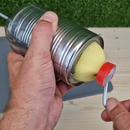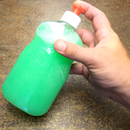Introduction: Simple Click on Click Off Circuit
In this Instructable I show you how to make a simple push to push off circuit with a 555 timer.
Because I have come across several projects that use this 555 timer and I had no idea what a 555 timer does exactly, I wanted to make a project to get to know it better. Therefore a simple circuit first.
The basic 555 timer gets its name from the fact that there are three internally connected 5kΩ resistors which it uses to generate the two comparators reference voltages. The 555 timer IC is a very cheap, popular and useful precision timing device which can act as either a simple timer to generate single pulses or long time delays, or as a relaxation oscillator producing a string of stabilised waveforms of varying duty cycles from 50 to 100%.
The 555 timer chip is extremely robust and stable 8-pin device that can be operated either as a very accurate Monostable, Bistable or Astable Multivibrator to produce a variety of applications such as one-shot or delay timers, pulse generation, LED and lamp flashers, alarms and tone generation, logic clocks, frequency division, power supplies and converters etc, in fact any circuit that requires some form of time control as the list is endless.
As I said, I'm going to start simple. In this project I am going to manually control the "flip flop" circuit in the 555 timer with 2 push buttons. One push button turns on the flip flop circuit causing the output to go high and the LED to light, the other push button resets the flip flop circuit causing the output to drop and the LED to turn off.
Video Tutorial
Supplies
- 555 timer
- 2 Tactile switches
- LED (any color)
- 470 Ohm resistor
- 9V battery
- 9V battery clip
Step 1: Connect Tactile Button to 555 Timer
The round dot on the top left of the 555 timer shows you what connection number 1 is. See the figure in the first step for pin numbering on the 555 timer.
Connect the tactile switch between pin 1 and pin 2.
Step 2: Mount the Resistor
To protect the LED, a resistor intervenes. This comes at the output (pin 3) of the 555 timer. Cut the pins and solder the 470 Ohm resistor to pin 3 of the timer.
Step 3: Mount the LED
The led to check if the output is high comes between the output (pin 3 with the resistor) and the ground (pin 1). Solder the LED between pin 1 and 3. The anode (+) of the LED must be connected to pin 3.
Step 4: The Reset Button
The second tactile button is placed between pin 5 and 6. When this button is pressed, the flip flop circuit is reset.
Solder the tactile button to pins 5 and 6.
Step 5: Mount the Battery Clip
The circuit is powered by a 9 volt battery. Solder the red cable from the battery clip to pin 8 (+ vcc) and the black cable to pin 1 (ground).
Step 6: Ready
Ready! Connect the 9 volt battery and the circuit can be tested. One button turns the LED on, the other button turns the LED off. A simple circuit has been added as an image to make it even clearer.
The 555 timer is very fragile. When soldering, make sure you don't let it get too hot, it can break it.
Video tutorial
I hope this Instructable helps you understand the 555 timer. It has made a lot of sense to me and I plan to do more projects with it because it has so many possibilities.




